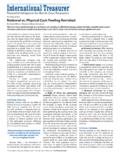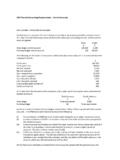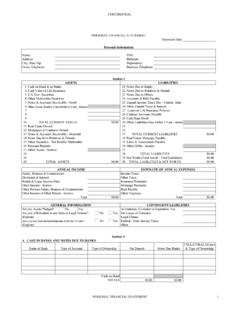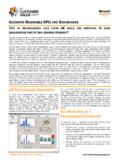Transcription of NAHB Chart of Accounts - Fay HBA
1 NAHB Chart of Accounts Page 1 of 39 April 2008 1000 1990 Assets 1000 1090 Cash 1010 Petty cash All of a company s petty cash Accounts , whether maintained in office or by construction superintendent in the field 1020 Cash on deposit, general Demand deposits in bank for all regular trade receipts and disbursements 1030 Cash on deposit, payroll Demand deposits in bank for payroll disburse-ments only (Generally, companies that employ their own crews and write a large number of payroll checks maintain a separate checking account to cover payroll. For each pay period, a check for the total amount of the payroll is written against the general account and deposited into the payroll account .)
2 1040 Cash on deposit, savings and money market Deposits in savings and money market Accounts 1050 Cash on deposit, held in escrow Cash held at title companies, disbursing agents, and financial institutions, representing refundable customer deposits, completion escrows, or other escrowed funds 1100 1190 Short-term Investments 1110 Certificates of deposit Funds deposited in interest-bearing certificates of deposit (CDs), maturing in less than one year 1120 Marketable securities Funds invested in readily marketable stock of unaffiliated companies that management intends to dispose of within one year (In accordance with generally accepted accounting principles [GAAP], these in-vestments should be carried at the lower of aggregate cost or market value.)
3 To adjust, credit this account and debit 2940, unrealized holding loss.) 1130 Government securities Funds invested in securities issued by federal, state, or local authorities maturing in less than one year 1190 Other short-term investments Funds invested in other instruments for set periods (usually less than one year) that earn interest or dividend income NAHB Chart of Accounts Page 2 of 39 April 2008 1200 1290 Receivables 1210 Accounts receivable, trade Amounts due to the business for construction, including customers orders for extras, management services, or other services performed on open account 1220 Accounts receivable, other Amounts due to the business for services not otherwise classified 1230 Notes receivable Unpaid balances due to the company on notes received in full or partial settlement of open or short-term Accounts 1250 Mortgage notes receivable.
4 Current year Mortgages taken from purchasers in lieu of cash; payments due within 12 months 1260 Due on construction and development loans Amounts due from financial institutions on construction and development loans (The balance of this account represents the amount of cash available from construction and development loans. When a loan is approved, debit this account to show how much cash is available through the loan, and credit 2220, acquisitions and development loans payable, or 2230, construction loans payable. As you draw cash from the loan, you decrease, or credit, 1260, due on construction and development loans, to show how much cash is available to draw from the loan.)
5 Alternatively, you can record draws against construction loans directly to account 2220, acquisitions and development loans payable, or 2230, construction loans payable.) 1265 Costs in excess of billings Primarily used by remodelers, custom builders, and commercial builders to record costs that exceed their estimated costs (sometimes referred to as under billing) based upon the percentage of completion method 1270 Accrued interest receivable Interest earned but not received from all sources such as bonds, notes, and mortgages 1280 Allowance for doubtful Accounts A contra account that has a credit balance reflecting the potential uncollectible amounts of any account in the receivables classification (A contra account reduces the balance of an account in this case, Accounts receivable without changing the account itself.
6 1290 Retentions (retainage) receivable Amounts withheld by customers on progress billings. (When retentions become due, debit 1220, Accounts receivable other, and credit 1290, retention receivable.) NAHB Chart of Accounts Page 3 of 39 April 2008 1300 1390 Inventories 1310 Construction materials inventory Control account for book value of con-struction materials purchased and stored, rather than delivered directly to a job in progress (As materials are allocated to a specific job, the cost is transferred and debited to 1430, direct construction cost, and credited to 1310, construction materials inventory.)
7 Excess materials purchased directly for a specific job and originally debited to 1430 should be debited to 1310 and credited to 1430 if the materials are transferred to inventory. Or they should be added to the cost of the house for which the materials are used.) 1320 Land held for development Control account for cost of land purchased for future development (The cost of land increases by recording fees, legal fees, and other acquisition costs. Debit cost of land to 1410, land and land development, at the time the land is to be developed, and credit 1320, land held for development.) 1330 Property held for remodeling Acquisition costs for properties held for future improvement or remodeling (Once the work is completed, they may be sold or held for investment.
8 NAHB Chart of Accounts Page 4 of 39 April 2008 1400 1490 Work in Progress 1410 Land and land development Control account for all land and land development costs (see Appendix G) (Cumulative cost of land and land development, including cost of raw land, financing and interest, land planning, engineering, grading, streets, curbs and gutters, sidewalks, storm sewers, temporary utilities, professional fees, permits, and other costs pertaining to the development of the raw land 1412 Accumulated allocations, land, and land development costs Accumulated write-offs to developed lots or to cost of sales for land and land development costs (At the time of closing, debit the cost of the lot to the appropriate cost of sales account in the 3500 to 3700 series and credit 1412.))
9 1420 Developed lots Cost of lots developed prior to purchase to be used for con-struction (When a house is closed, debit the cost to the appropriate cost of sales account in the 3500 to 3700 series.) 1425 Reserve for impairment on developed lots Reserve to reflect lower of cost or market value of developed lots 1430 Direct construction cost Control account for all direct construction costs (see Appendix E) including permits, direct labor, materials, trade contractors, equipment rentals and any other direct charge to the units under construction (This account must be supported by a job cost subsidiary detailing the cost of each construction unit.)
10 It also includes finance and interest charges during construction. Don t include marketing costs or indirect construction costs in this account . When a house is closed, debit the cost to the appropriate cost of sales account in the 3500 to 3700 series.) 1440 Indirect construction cost A control account that requires a detailed breakdown in a subsidiary ledger showing the different types of cost accumulated in this account (By adding an additional two digits to establish sub Accounts , a detailed breakdown of the indirect construction costs can be accommodated in the general Chart of Accounts [see Appendix F].





